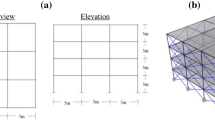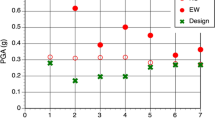Abstract
Over the past two decades, as the cost of natural disasters has skyrocketed in the United States, much emphasis has been placed on mitigating these hazards. From earthquakes to floods to hurricanes, agencies such as the Federal Emergency Management Agency (FEMA), the Institute for Business and Home Safety (IBHS), and the Association of Bay Area Governments (ABAG) have tried to increase public awareness of natural hazard risk and encourage those at risk to mitigate for the hazard. At the same time, advanced software tools have emerged to allow stakeholders to more accurately assess their hazard risk exposures. These include the proprietary catastrophe models used by the insurance and reinsurance industries and the federal government’s model, HAZUS®.
Access this chapter
Tax calculation will be finalised at checkout
Purchases are for personal use only
Preview
Unable to display preview. Download preview PDF.
Similar content being viewed by others
References
Boardman A, Greenberg D, Vining A, Weimer D (2001) Cost-benefit analysis: Concepts and practice. Prentice Hall, Upper Saddle River, New Jersey
Boore DM, Joyner WB, Fumal TE (1997) Equations for estimating horizontal response spectra and peak acceleration from western North American earthquakes: A summary of recent work. Seismological Research Letters 68:128–153
Chang SE (2003) Evaluating disaster mitigations: Methodology for urban infrastructure systems. Natural Hazards Review 4:186–196
Dodo A, Xu N, Davidson R, Nozick LK (2005) Optimizing regional earthquake mitigation investment strategies. Earthquake Spectra 21:305–327
FEMA (1994) Assessment of the state of the art earthquake loss estimation methodologies (FEMA 249). Federal Emergency Management Agency, Washington, DC
FEMA (1997) Report on costs and benefits of natural hazard mitigation (FEMA Publication 294). Federal Emergency Management Agency, Washington, DC
FEMA (1998) Protecting business operations: Second report on costs and benefits of natural hazard mitigation (FEMA Publication 331). Federal Emergency Management Agency, Washington, DC
FEMA (2002a) HAZUS®99 SR2 User’s Manual. Federal Emergency Management Agency, Washington DC
FEMA (2002b) State and local plan interim criteria under the disaster mitigation act of 2000. Federal Emergency Management Agency, Washington, DC
FEMA (2002c) A guide to using HAZUS® for mitigation. Federal Emergency Management Agency, Washington DC
FEMA (2003) State and local mitigation planning how to guide (Report No. 386-3). Federal Emergency Management Agency, Washington, DC
Grossi P (1998) Assessing the benefits and costs of earthquake mitigation (Working Paper 98-11-11). Risk Management and Decisions Processes Center, The Wharton School, Philadelphia, Pennsylvania
Grossi P (2000) Quantifying the uncertainty in seismic risk and loss estimation. Doctoral Dissertation, University of Pennsylvania
Grossi P, Kunreuther H (eds) (2005) Catastrophe modeling: A new approach to managing risk. Kluwer Academic Publishers, Norwell, MA
Insurance Information Institute. (2006) Catastrophes [online]. Retrieved 10 June 2006, from http://www.iii.org/media/hottopics/additional/isofactsheet/
Kunreuther H, Cyr C, Grossi P, Tao W (2001) Using cost-benefit analysis to evaluate mitigation for lifeline systems. MCEER research projects and accomplishments: 2000–2001
Mahaney JA, Paret TE, Kehoe BE, Freeman SA (1993) The capacity spectrum method for evaluating structural response during the Loma Prieta earthquake. In: Proceedings of the 1993 United States National Earthquake Conference
Multihazard Mitigation Council (2005) Natural hazard mitigation saves: An independent study to assess the future savings from mitigation activities. National Institute of Building Sciences, Washington, DC
NIBS (1997) HAZUS®: Hazards U.S.: Earthquake loss estimation methodology (NIBS Document Number 5200). National Institute of Building Sciences, Washington, DC
Seligson HA, Blais NC, Eguchi RT, Flores PJ, Bortugno E (1998) Regional benefit-cost analysis for earthquake hazard mitigation: Application to the Northridge earthquake. In: Proceedings of the Sixth U.S. National Conference on Earthquake Engineering. Seattle, Washington
Seligson HA, Ballantyne DB, Huyck CK, Eguchi RT, Bucknam S, Bortugno E (2003) URAMP (utilities regional assessment of mitigation priorities) — a benefit-cost analysis tool for water, wastewater and drainage utilities: Methodology development. In: Proceedings of the Sixth U.S. Conference on Lifeline Earthquake Engineering, American Society of Civil Engineers, Technical Council on Lifeline Earthquake Engineering (ASCE TCLEE). Long Beach, California
Smyth AW, et al (2004) Probabilistic benefit-cost analysis for earthquake damage mitigation: Evaluating measures for apartment houses in Turkey. Earthquake Spectra 20:171–203
SSC (2003) Status of the unreinforced masonry building law, 2003 report to the legislature (SSC 2003-03). Seismic Safety Commission, Sacramento, CA
Steinbrugge KV (1982) Earthquakes, volcanoes, and tsunamis: An anatomy of hazards. Skandia America Group, New York, New York
Stover CW, Coffman JL (1993) Seismicity of the United States, 1568–1989 (U.S. Geological Survey Professional Paper 1527). United States Government Printing Office, Washington, DC
Author information
Authors and Affiliations
Editor information
Editors and Affiliations
Rights and permissions
Copyright information
© 2008 Springer-Verlag Berlin Heidelberg
About this chapter
Cite this chapter
Grossi, P. (2008). Modeling Seismic Mitigation Strategies. In: Bostrom, A., French, S., Gottlieb, S. (eds) Risk Assessment, Modeling and Decision Support. Risk, Governance and Society, vol 14. Springer, Berlin, Heidelberg. https://doi.org/10.1007/978-3-540-71158-2_10
Download citation
DOI: https://doi.org/10.1007/978-3-540-71158-2_10
Publisher Name: Springer, Berlin, Heidelberg
Print ISBN: 978-3-540-71157-5
Online ISBN: 978-3-540-71158-2
eBook Packages: Business and EconomicsEconomics and Finance (R0)




